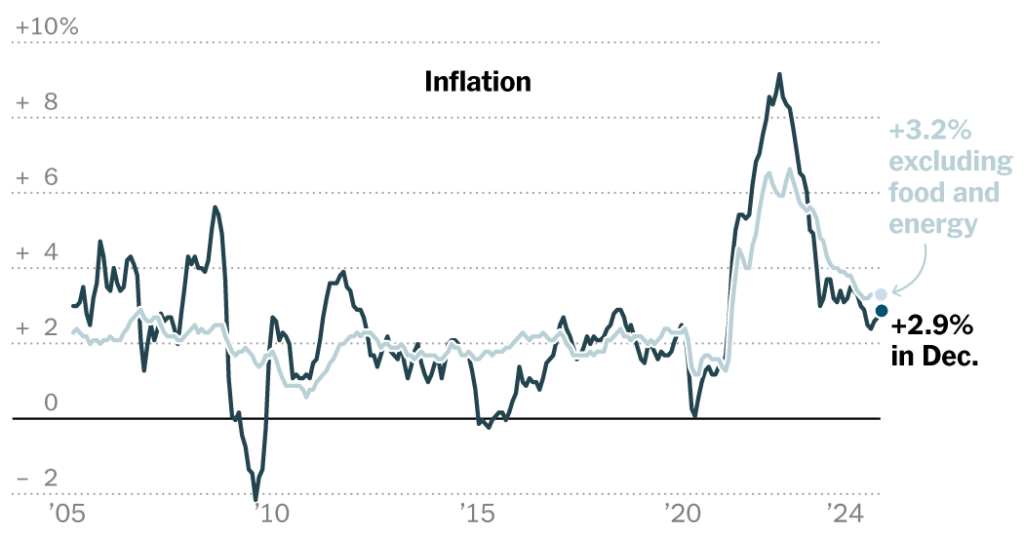Consumer prices rose more quickly in December, the latest sign that the Federal Reserve’s fight against inflation may have stalled.
The Consumer Price Index rose 0.4 percent from November, and was up 2.9 percent from a year earlier, the Labor Department said on Wednesday. It was the fastest one-month increase in overall prices since February, driven in part by another sharp rise in the price of eggs and other groceries.
The “core” measure of inflation, which strips out volatile food and fuel prices to give a better sense of the underlying trend, was more encouraging: The index rose 3.2 percent from a year earlier after three straight months of 3.3 percent gains. Forecasters had not expected core inflation to slow.
Inflation has cooled substantially since the middle of 2022, when it hit a four-decade high of more than 9 percent. More recently, however, progress has slowed, or even stopped outright: By some measures, inflation hardly improved in 2024.
“When you step back and look at the overall state of inflation, we’re not really going anywhere,” said Sarah House, senior economist at Wells Fargo. “While there has been progress, the pace has been really disappointing.”
Prices continued to rise in some of the categories that matter most to consumers. Grocery prices, which were relatively flat in late 2023 and early 2024, are rising again, led by the price of eggs, which is up by more than a third over the past year. Gas prices jumped 4.4 percent in December, although they were lower than a year ago.
And with inflation proving more stubborn than policymakers had hoped, Americans will likely need to wait longer to see lower interest rates on their mortgages, car loans and credit card balances.
Officials at the Fed have voiced increasing concern about the slow progress on inflation, and while some of the details in Wednesday’s report were encouraging, the data is unlikely to do much to ease those concerns. Stock prices rose and bond yields fell on Wednesday as investors breathed a sigh of relief that the inflation data wasn’t worse. The S&P 500 rose 1.8 percent, its best one-day performance since the election in November. The 10-year Treasury yield, which underpins interest rates from mortgages to corporate loans, fell 0.15 percentage points, its biggest one-day fall in almost six months.
At the same time, the continued strength of the labor market — including data released last week showing unexpectedly strong job growth in December — has made policymakers less worried that their efforts to rein in price increases were leading to layoffs or causing damage to the broader economy.
As a result, investors widely expect the central bank to hold interest rates steady at its meeting later this month. That would break a streak of three consecutive rate cuts, and some forecasters now say that policymakers may not lower rates at all this year.
“With a labor market that’s stabilizing, with inflation already above target and with risks further to the upside, I think it’s difficult to make a case to keep cutting,” said Aditya Bhave, an economist at Bank of America.
Most Fed officials have said they still expect inflation to cool gradually, and economists agree that there’s reason to be optimistic. Inflation in housing — by far the biggest monthly expense for most families, and one of the most stubborn categories of consumer prices — has finally begun to ease: Shelter prices were up 4.6 percent in December from a year earlier, the smallest 12-month increase in nearly three years. Services prices outside housing — a measure that Fed officials have watched closely in recent years as an indication of where overall inflation is headed — also continued to cool. And data released on Tuesday showed that wholesale prices rose more slowly in December.
But policymakers are facing a new source of uncertainty: President-elect Donald J. Trump. The incoming president has promised to impose steep tariffs on imports, restrict immigration and cut taxes — policies that economists warn could push up prices further, although it is unclear by how much. Some Fed officials have said they are already factoring those policies into their outlook for inflation.
With price increases proving stubborn and the labor market looking strong, policymakers are unlikely to cut rates again until they get a clearer picture of what policies the new administration is adopting and how they are affecting the economy, said James Egelhof, chief U.S. economist at BNP Paribas.
“The Fed has the luxury of a little bit of time to wait for President Trump to take office and to see exactly what happens,” he said.
Joe Rennison contributed reporting.


